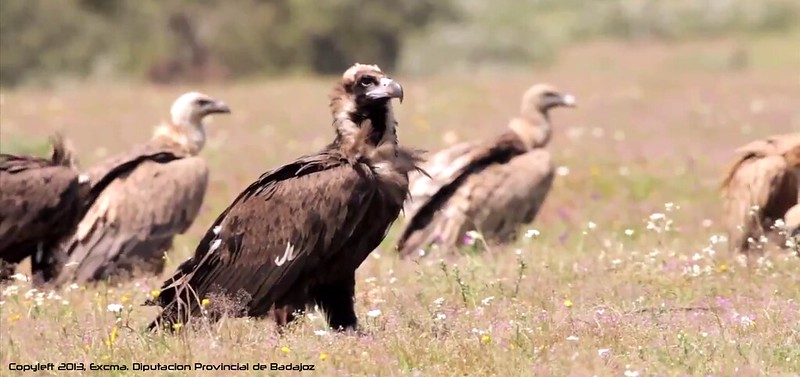The Cinereous Vulture (Aegypius monachus) was taking its time to let itself be seen. The death cow that had been lying in the middle of the pasture for the last two days smelled rotten. After the arrival of several magpies, the Griffon Vultures showed up and started to rip its entrails. Six Griffon Vulture specimens were devouring the corpse when two big black shadows appeared on the sky and flew down at high speed. They were two Cinereous Vultures, which chased the other guests several metres away with hisses and threats. When the Cinereous Vulture eats, nobody disturbs. This is the established hierarchical order. Little by little, the Cinereous Vultures were ripping the muscle mass of the death animal. Until they were satisfied and moved away, nobody approached the death cow.
This is a common scene in the fields of south Europe. With a wingspan of almost three metres and a weight of 10 kg, the Cinereous Vulture strongly surpasses the voracity of the Griffon Vulture. Its family name comes both from the Latin word monachus and the Greek word monakhos, which mean “monk”, due to the similarity between the black plumage cape of the bird and the monk’s habit.
Nowadays, this vulture is distributed between two colonies in Asia and Europe. The latter is located almost entirely in the Iberian Peninsula, although small colonies of Cinereous Vulture have been successfully reintroduced in Greece and France. In Spain they are present in the centre and south of the country. Since 2007, GREFA is trying to reintroduce them into the Pyrenees to favour the mobility of specimens between the Spanish colony and the small colonies in the rest of Europe. The world population of Cinereous Vulture is nowadays estimated to be about 9 000 couples, from which 1 400 are in Spain, Extremadura being the bastion of the species with 650 couples.
This long-lived species can live up to 40 years. It reaches sexual maturity relatively late, and its life expectancy is limited to an enormous nest with a single egg. This, combined with the fact that its preferred habitat is the almost virgin Mediterranean forest, the upturn of poison and the prohibition of leaving abandoned carrion on the land, is threatening this vulture day after day.
During 10 years of research on death by poison in Spain, the corpses of 500 poisoned vultures have been collected. For this reason, we would like to appeal to avoid freely spreading poison on our fields. The peak of the food pyramid is constituted by these birds that, on the other hand, play a beneficial role eliminating the carrion of the field, and thus avoiding the proliferation and spreading of diseases.
The last problem for this species is the pressure put by the presence of humans, given that Cinereous Vultures breed in quite large and appealing platforms that are often situated at a low height. The presence of hikers or off-road vehicles affect them and make them very vulnerable. For this reason, every colony should have a protection regime and be included in management plans of the species. They should carry out educational campaigns in areas of special awareness and look for the compromise of the landowners where the vulture is present in order to eradicate the use of poison. Moreover, it would be advisable to create supplementary feeding programmes, not only to make an extraordinary contribution, but also to prevent them from being affected by poison.












